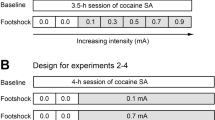Abstract
Presenting independently established discriminative stimuli in compound can substantially increase response rates under food and shock-avoidance schedules. To determine whether this effect extends to drug self-administration, rats were trained to press a lever to receive cocaine intravenously. A tone and a light were independently established as discriminative stimuli for cocaine self-administration, then presented in combination in a stimulus-compounding test. Compared to tone and light alone, the tone-plus-light compound stimulus increased responding approximately three-fold when cocaine was withheld during testing, and it increased drug intake approximately two-fold when cocaine was made available during testing. Compounding did not increase responding after training in a truly random control condition where tone and light were presented uncorrelated with the availability of cocaine. The results obtained with this animal model of drug abuse define conditions under which combinations of environmental stimuli might substantially increase human drug use.
Similar content being viewed by others
References
Balster RL, Schuster CR (1973) Fixed-interval schedule effects of cocaine reinforcement: effect of dose and infusion duration. J Exp Anal Behav 20: 119–129
Bickel WK, Kelly TH (1988) The relationship of stimulus control to the treatment of substance abuse. NIDA Res Monogr 84: 122–140
Bindra DA (1972) A unified account of classical conditioning and operant training. In: Black MA, Prokasy WF (eds) Classical conditioning, vol. 2. Current research and theory. Appleton-Century-Crofts, New York, pp 453–481
Brimer CJ (1970) Disinhibition of an operant response. Learn Motiv 1: 346–371
Caine SB, Koob GF (1994) Effects of mesolimbic dopamine depletion on responding maintained by cocaine and food. J Exp Anal Behav 61: 213–221
Childress AR, McLellan AT, Ehrman RN, O'Brien CP (1987) Extinction of conditioned responses in abstinent cocaine or opioid users. NIDA Res Monogr 76: 189–195
Emurian HH, Weiss SJ (1972) Compounding discriminative stimuli controlling free operant avoidance. J Exp Anal Behav 17: 249–256
Goldberg SR, Kelleher RT (1976) Behavior controlled by scheduled injections of cocaine in squirrel and rhesus monkeys. J Exp Anal Behav 14: 33–46
Goldberg SR, Schuster CR (1970) Conditioned nalorphine-induced abstinence changes: persistence in post morphine-dependent monkeys. J Exp Anal Behav 14: 33–46
Gray JA (1965) Stimulus intensity dynamism. Psychol Bull 63: 180–196
Hull CL (1949) Stimulus intensity dynamism (V) and stimulus generalization. Psychol Rev 56: 67–76
Kleven MS, Woolverton WL (1990) Effects of continuous infusions of SCH 23390 on cocaine- or food-maintained behavior in rhesus monkeys. Behav Pharmacol 1: 365–373
Markou A, Weiss F, Gold LH, Caine B, Schulties G, Koob GF (1993) Animal models of drug craving. Psychopharmacology 112: 163–182
Melnick J (1972) The effects of summated stimuli with retarded children. J Exp Child Psychol 14: 277–286
Meltzer D, Hamm RJ (1976) Response summation in the pigeon. Bull Psychon Soc 7: 515–518
Monti PM (1995) Smoking and alcohol abuse: implications for research treatment and policy. Presented at the meeting of the Eastern Psychological Association, Boston
O'Brien CP, Childress AR, Arndt IO, McLellan AT, Woody GE, Maany I (1988) Pharmacological and behavioral treatment of cocaine dependence: controlled studies. J Clin Psychiatry 49: 17–22
Pavlov IP (1927) Conditioned reflexes. Oxford University Press, Oxford
Pert A (1994) Neurobiological mechanisms underlying the acquisition and expression of incentive motivation by cocaine-associated stimuli: relationship to craving. NIDA Res Monogr 145: 163–190
Rescorla RA (1968) Probability of shock in the presence and absence of CS in fear conditioning. J Comp Physiol Psychol 65: 55–60
Robinson TE, Berridge KC (1993) The neural basis of drug craving: an incentive-sensitization theory of addiction. Brain Res Rev 18: 247–291
Schindler CW, Katz JL, Goldberg SR (1988) The use of second-order schedules to study the influence of environmental stimuli on drug seeking behavior. NIDA Res Monogr 84: 180–195
Sidman M (1960) Tactics of scientific research. Basic Books, New York
Siegel S (1989) Pharmacological conditioning and drug effects. In Goudie AJ, Emmet-Oglesby MW (eds) Psychoactive drugs: tolerance and sensitization. Humana, Clifton, N.J., pp 115–180
Weeks JR (1962) Experimental morphine addiction: method for automatic intravenous injections in unrestrained rats. Science 138: 143–144
Weiss SJ (1964) Summation of response strengths instrumentally conditioned along a composite stimulus continuum during free-operant summation. J Exp Psychol 68: 151–155
Weiss SJ (1969) Attentional processes along a composite stimulus continuum during free-operant summation. J Exp Psychol 82: 22–27
Weiss SJ (1970) An effective and economical sound-attenuation chamber. J Exp Anal Behav 13: 37–39
Weiss SJ (1971) Discrimination training and stimulus compounding: consideration of nonreinforcement and response differentiation consequences of SD. J Exp Anal Behav 15: 387–402
Weiss SJ (1972) Stimulus compounding in fee-operant and classical conditioning: a review and analysis. Psychol Bull 78: 189–208
Weiss SJ (1976) Stimulus control of free-operant avoidance: the contribution of response and incentive relations between multiple-schedule components. Learn Motiv 7: 476–516
Weiss SJ (1977) The isolation of stimulus-reinforcer associations established with multiple schedules. Anim Learn Behav 5: 421–429
Weiss SJ (1978) Discriminated response and incentive processes in operant conditioning: a two-factor model of stimulus control. J Exp Anal Behav 30: 361–381
Weiss SJ, Schindler CW (1989) Integrating control generated by positive and negative reinforcement on an operant baseline: appetitive-aversive interactions. Anim Learn Behav 17: 433-
Weiss SJ, Schindler CW, Eason R (1988) The integration of habits maintained by food and water reinforcement through stimulus compounding. J Exp Anal Behav 50: 237–247
Wolf MM (1963) Some effects of combined SDs. J Exp Anal Behav 6: 343–347
Author information
Authors and Affiliations
Rights and permissions
About this article
Cite this article
Panlilio, L.V., Schindler, C.W. & Weiss, S.J. Cocaine self-administration increased by compounding discriminative stimuli. Psychopharmacology 125, 202–208 (1996). https://doi.org/10.1007/BF02247329
Received:
Revised:
Issue Date:
DOI: https://doi.org/10.1007/BF02247329




